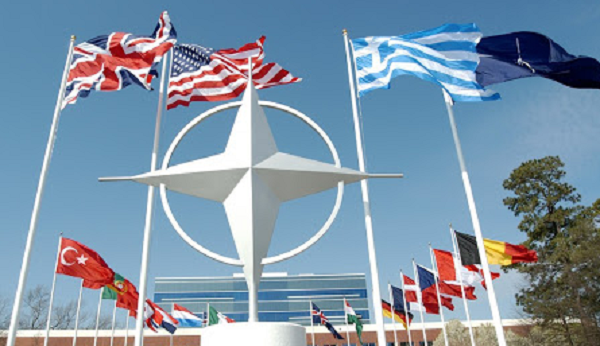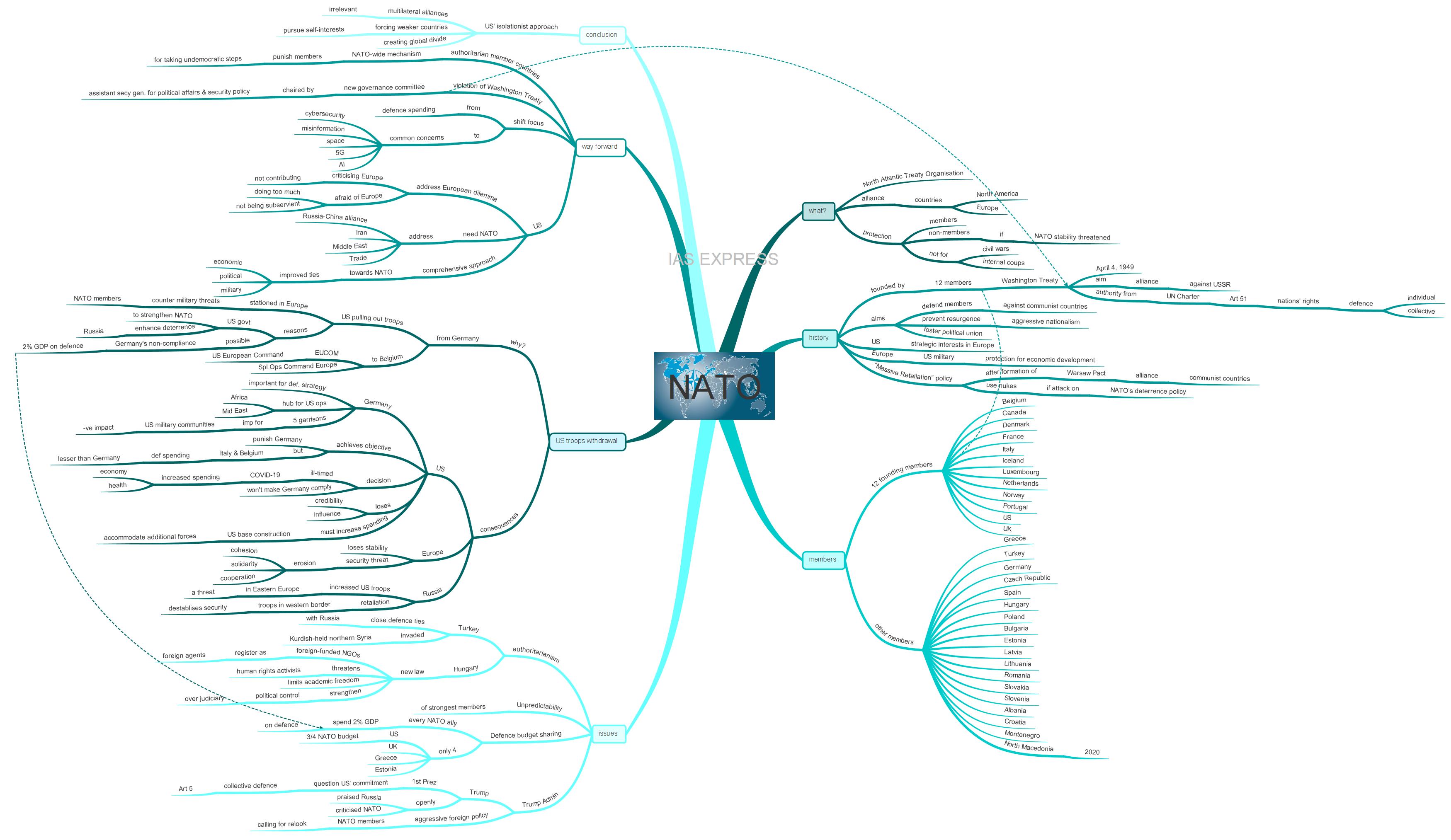North Atlantic Treaty Organisation (NATO) – Issues, Challenges, Way Ahead

Almost 12,000 US troops are to be pulled out from Germany by the Trump Administration, adding to the tensions within the NATO. This is in response to Berlin’s non-compliance to increased defence spending. This decision resulted in widespread criticism as it is undermining a strong symbol of Washington’s commitment to its European allies, creating a rift among the NATO members and emboldening Russia and China, the adversaries of the US, to increase their presence in Europe.
What is NATO?
- The North Atlantic Treaty Organisation (NATO) is an alliance of 30 countries that span over North America and Europe.
- It includes most of the EU members, the US, Canada and Turkey.
- It provides military protection to the member nations and non-member countries if its stability is threatened. However, this protection does not extend to civil wars or internal coups.
- It is currently facing an internal crisis because of the lack of unity among the member countries, which has intensified significantly during the Trump presidency.
How did NATO come to be?
- NATO was founded by 12 member states following the signing of the Washington Treaty on April 4, 1949.
- The aim of the treaty was to create an alliance to counter the Soviet Union and its influence in Western Europe.
- The treaty derives its authority from Article 51 of the UN Charter, which confers the inherent rights to a nation to “individual or collective self-defence”.
- NATO’s main objective is to defend member nations from threats by communist countries.
- It sought to prevent the resurgence of aggressive nationalism and foster political union.
- For the US, NATO plays a significant role in its strategic interests in Europe.
- The US military protection gave the European Union members the much-needed security to rebuild after the Second World War.
- The NATO adopted a “Massive Retaliation” policy in response to the formation of the Warsaw Pact, an alliance of communist countries led by the USSR.
- The policy promised the use of nuclear weapons if the Pact attacked NATO’s deterrence policy. This enabled Europe to focus on economic development without the need for building conventional armies.
Who are the current members of NATO?
- Currently, NATO has 30 members.
- In 1949, there were 12 founding members of the Alliance – Belgium, Canada, Denmark, France, Italy, Iceland, Luxembourg, the Netherlands, Norway, Portugal, the UK and the US.
- The other members who later joined the multilateral alliance are Greece, Turkey, Germany, Spain, the Czech Republic, Hungary, Poland, Bulgaria, Estonia, Latvia, Lithuania, Romania, Slovakia, Slovenia, Albania, Croatia, Montenegro and North Macedonia.
- North Macedonia is the latest to join the grouping in the year 2020.
What are the issues with NATO?
Currently, NATO is grappling with major strategic challenges, both from inside and outside. Apart from threats from actors like Russia, there are also fundamental challenges emanating from within, like its role in new and emerging security domains. Some of the challenges from within include the following:
The weakening of democratic ideologies
- NATO is based on democratic ideology – a contrast to the authoritarianism propagated by countries like Russia and China.
- However, the democratic backsliding by some of its own members like Turkey and Hungary is posing a major threat to this alliance.
- Since the failed coup attempt in July 2016, Turkish President Erdogan has cracked down on freedoms within the country, leading to a push of an authoritarian government.
- It has also ensured close defence partnership with Russia by purchasing S-400 and launched an invasion into Kurdish-held northern Syria. Both these moves were condemned by the rest of the NATO members.
- As for Hungary, it adopted a law that requires foreign-funded NGOs to register as foreign agents. This law is said to threaten human rights activists, limit academic freedom and strengthen political control over the judiciary.
- Such trends from Turkey and Hungary are threatening the very foundation of the NATO grouping.
Unpredictability
- The unpredictability of some of the strongest members of NATO, especially the US, is another internal threat for the alliance.
- The US President Trump called the alliance “obsolete”, stating that the US is not benefiting from NATO.
Defence budget sharing
- Every NATO ally is supposed to spend 2% of its GDP on defence.
- Only few countries reach this target, including the US, the UK, Greece and Estonia.
- The US contributes three-fourths of NATO’s budget.
- Thus, Trump, since being elected, has been vociferous about this issue.
Trump Administration
- President Trump is the first US President to question the US commitment to Article 5, which states that one attack against one ally shall be considered an attack against all allies.
- He also threatened that the US may not come to aid another NATO member in case of external military aggression. This weakens the very foundation of the organisation and encourages external actors to make use of the crisis.
- Because of Trump’s aggressive foreign policies, the French President Macron and German Chancellor Merkel are of the opinion that the alliance has weakened and needs a relook.
- Trump’s open praise of Russia’s Vladimir Putin and criticism of NATO have led the member nations to believe that they can no longer rely on the US as an ally in case of attack.
The US pulling troops out of Germany:
Why is the US pulling troops out of Germany?
- As a part of NATO, US troops are stationed in member states all across Europe to counter any military threats to any of the NATO members. The treaty commits all members to share risk, responsibilities and benefits of collective defence.
- The US is planning to withdraw a large chunk of its troops from Germany and distribute part of them throughout other European countries.
- According to the US government, the repositioning of the military personnel from Germany, from roughly 36,000 down to 24,000 is to strengthen NATO, enhance deterrence of Russia and meet other principles.
- Trump, since 2019, has been threatening to pull out troops from Germany because of the latter’s non-compliance with the 2% GDP for defence commitment. It is evident that this might be the reason behind this move as Russia is not posing a significant security threat to NATO. Germany’s spending has not reached the 2% mark, its goal was to spend 1.5% by 2024 and reach 2% by 2031.
- The US European Command (EUCOM) and Special Operations Command Europe will also be moved from Stuttgart in Germany to Belgium.
What are the consequences of this move?
For the US:
- For the US, it is a strategic failure, as Germany, since the end of World War II, has played a critical role in the US defence strategy, the reason behind the US’ decision to base its EUCOM headquarters there.
- Germany is a hub for US operations in the Middle East and Africa.
- The US currently has five garrisons in Germany and several US military communities have developed around few Germany towns. In these towns, many jobs are tied to the bases.
- Losing bases worsens the economic effects caused by the COVID-19 pandemic for these towns.
- The relocation of troops does successfully punish Germany – the intended objective of the Trump Administration.
- Yet, this argument loses its power, as two of the countries the US wants to redirect its troops to, Italy and Belgium, are spending less of their GDP on defence than Germany.
- Also, the decision is ill-timed as the coronavirus pandemic forced the countries to spend more on health and economic upliftment.
- This move would not force Germany to increase its spending on defence because of the coronavirus crisis.
- The US, not only loses its influence but also its credibility.
- It also has to increase its spending for construction of US bases to accommodate additional forces.
For Europe:
- Europe would lose its stability because of the US’ call for increased defence spending.
- The deterrence power of NATO does not depend on defence spending but on cohesion, solidarity and cooperation.
- The erosion of these aspects increases the security threat for Europe.
For Russia:
- The move creates a threat for Russia due to increased deployment of US troops in NATO’s eastern states like Poland, the Baltic states or Romania.
- It creates the possibility of Kremlin re-stationing troops closer to its western border, which would destabilise the current security situation.
- The timing of the US’ move is questioned when Russia is not acting provocatively towards NATO/Europe.
What can be the way forward?
- NATO, despite the identity crisis and differences, remains relevant, as it has the capability to deter and defend its members from outside actors, ensure military readiness among the allies and tackle new domains.
- United efforts to retain the relevance of this alliance can be achieved by addressing the heart of the issues plaguing NATO’s cohesion.
- The member countries must first deal with those countries that are leaning towards authoritarianism.
- NATO should ensure that the shared democratic values remain intact. The NATO-wide mechanism for punishing members who may take undemocratic steps must be put in place or there may be a security threat for the alliance.
- A new governance committee, established under the chairmanship of NATO’s assistant secretary-general for political affairs and security policy can be set up to address the violation of the principles of the Washington Treaty, NATO’s founding document.
- The alliance can shift the focus away from defence spending, though the European countries must do more towards ensuring collective defence.
- Instead, NATO leaders can focus on areas of common concerns like cybersecurity, fighting misinformation, space, 5G and artificial intelligence.
- The US must take substantial steps in addressing its European dilemma, which involves wanting Europe to do more but also fearing that Europe will do too much and will no longer be subservient to Washington.
- While Russia is not posing threats as it did during the Cold War Era, there are still areas of concern, like Iran, the Middle East and trade.
- The alliance between Russia and China poses a tangible threat to the interests of the US.
- The narrow-minded approach towards NATO by the US as being purely a military alliance does not create favourable outcomes while addressing the aforementioned issues.
- Therefore, the US should improve its economic, political and military relations with the NATO nations to ensure that its strategic interests remain in place
Conclusion:
The isolationism propagated by Trump Administration has made several key multilateral groups like NATO, G7 etc., irrelevant as it is forcing weaker countries to pursue their own interests instead of relying on major powers. This creates a rift, which in turn prevents international cooperation, especially during a pandemic that can be addressed only through strong and united efforts of all countries.
Practice question for mains:
US’ protectionist foreign policy strategy threatens multilateral alliances and international organisations. Elucidate (250 words)
If you like this post, please share your feedback in the comments section below so that we will upload more posts like this.






